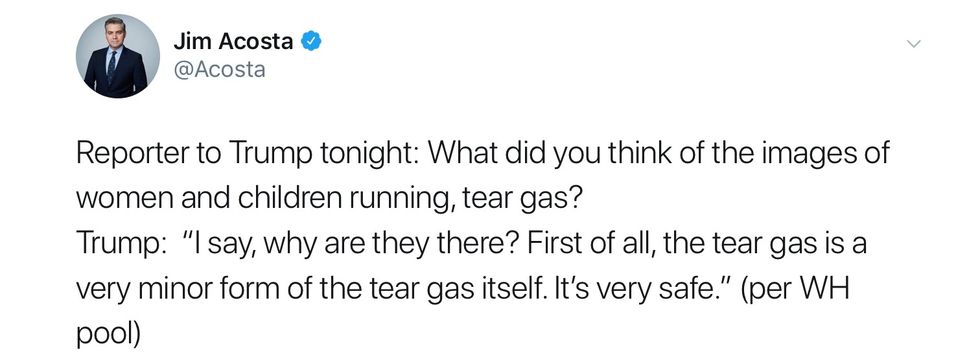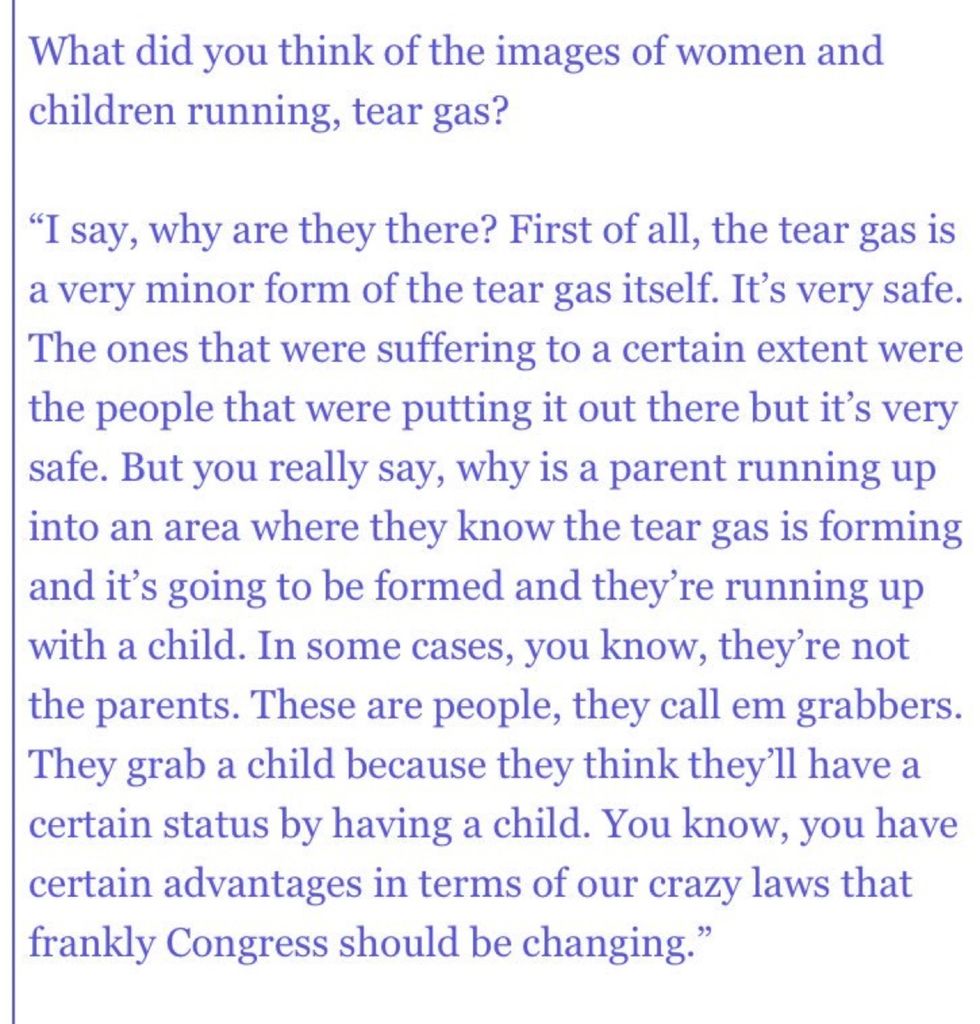Military recruits enter the chamber one by one and don protective masks. Tear gas swirls. Then, the order: Take off your mask and breathe. Eyes well and throats tighten, and men and women training for war uncontrollably gag.
Nearly every uniform is coated in snot. Some recruits vomit.
The exercise demonstrates to troops that their equipment works. It also shows, in a visceral way, what happens if an enemy targets U.S. forces with an agent such as tear gas, commonly known as CS gas — an aerosol compound considered a chemical weapon that has been outlawed on the battlefield by nearly every nation on Earth, including the United States.You might know tear gas as a non-lethal weapon used by law enforcement for crowd control. However, there's much more to the chemical agent. (Adriana Usero/The Post)
But as a riot-control agent, 2-chlorobenzalmalononitrile is legal to use by both police and federal authorities in the United States and many other countries.
On Sunday, U.S. Customs and Border Protection agents fired the chemical agent at mostly Honduran migrants attempting to cross into the United States from Tijuana, Mexico — an unusual escalation of lobbing weapons over an international border at unarmed civilians seeking refuge, drawing condemnation from Democrats.
"I felt that my face was burning, and my baby fainted. I ran for my life and that of my children," Cindy Milla, a Honduran migrant with two children, told the Wall Street Journal.
Chief Patrol Agent Rodney S. Scott, the senior Border Patrol agent for the San Diego area, defended the use of the gas, telling CNN that three of his personnel were struck by rocks or debris that also "dented" vehicles. None of his agents was seriously injured, he said.
On Monday evening, Trump questioned why a parent would run into an area filling with tear gas, saying without evidence that some adults grabbed unrelated children "because they think they will have a certain status by having a child."
Soon after, Homeland Security Secretary Kirstjen Nielsen said in a statement which never mentions tear gas that "the accepted use of nonlethal force (also used by the Obama Administration in 2013) prevented further injury to agents and a mass illegal rush across the border."President Trump defended Nov. 26 the use of tear gas against members of the Central American migrant caravan who rushed the fencing along the U.S. border. (The Post)
Chemical weapons such as CS gas are indiscriminate and "uniquely terrorizing in their application," which necessitated their ban in combat in 1993, said Kelsey Davenport, director of nonproliferation policy at the Washington-based Arms Control Association.
Once launched in a volley or thrown into an area, chemical weapons cannot be controlled and can drift toward people who are not targets, Davenport told The Washington Post on Monday.
In battle, that would include civilians and wounded troops, and even friendly soldiers if the winds shift. U.S. battle planners in World War I accounted for U.S. casualties from its own asphyxiating gas attacks.
On the border Sunday, officials described aggressive men rushing fencing, necessitating a response that included tear gas.
But women and children, some in diapers, also came into contact with tear gas, raising questions about whether the use of gas was an appropriate response.
Research has noted that an infant exposed to CS gas develops severe pneumonitis and requires a month of hospitalization. But the effects of tear gas on younger bodies is not well documented, said Anthony H. Cordesman, a biological and chemical weapons expert at the Washington-based Center for Strategic and International Studies.
"We don't have the ability to easily predict effects unless there is more history of use against children," Cordesman told The Post. "It looks like we're setting the precedent."
Scott, the senior Border Patrol agent, said 42 people, mostly men, were apprehended on the U.S. side of the border.
A CBP spokesman did not return a request for comment on agency policies for when it is appropriate to use CS gas, whether there concerns about firing over the border, or how many rounds were fired. No serious injuries of migrants were reported.
Photos of children and mothers fleeing from tear gas could sour public opinion on the border operations itself, Cordesman noted.
"You don't want to escalate force to a level that discredits your operation," he said.
The photos outraged Democrats critical of President Trump's response to the migrant caravan. Gavin Newsom, the Democratic governor-elect of California, argued that images of kids sprinting from tear gas run counter to American ideals.
"These children are barefoot. In diapers. Choking on tear gas," he tweeted. "Women and children who left their lives behind — seeking peace and asylum — were met with violence and fear. That's not my America. We're a land of refuge. Of hope. Of freedom. And we will not stand for this."
Tear gas was used during protests in Ferguson, Mo., after the 2014 police shooting death of Michael Brown, drawing similar rebukes from rights groups and citizens who said the police response was disproportionate.Middle Eastern and African countries typically use CS gas more potent than what U.S. authorities wield — with devastating results.
In 2013, Egyptian police fired tear gas into the back of a vehicle carrying supporters of ousted president Mohamed Morsi to prison, asphyxiating and killing 37 people. An attorney for the men posted photos of one corpse on Twitter with a face so darkened that families believed at first that the victims burned to death.
Other people have been killed by inhaling CS gas or by the projectiles themselves.
The first of subsequent chemical weapons ban occurred after World War I, Davenport said, after the international community was shocked by twisted corpses in the trenches and horrific wounds of troops who survived with blistered skin and scarred lungs.
In the modern era, the use of chemical weapons by Iraqi leader Saddam Hussein in war and against Iraqi civilians was a factor to push for a total ban of chemical agents, Davenport said.
The 1993 Chemical Weapons Convention banned not only the use of chemical weapons in war but also the production and stockpiling of weapons for 193 signatories, she said.
Israel has signed but not ratified the convention. North Korea, Egypt and South Sudan have not taken action.
Alex Horton is a general assignment reporter for The Washington Post. He previously covered the military and national security for Stars and Stripes, and served in Iraq as an Army infantryman. He wrote this in the Washington Post, November 26, 2018.
###
November 27, 2018
Post Script. Tear gas! A new phase of Trump's war on immigrants! The mad emperor even suggested it is safe.


Remember. January 1 is soon here. #TheEndBegins

